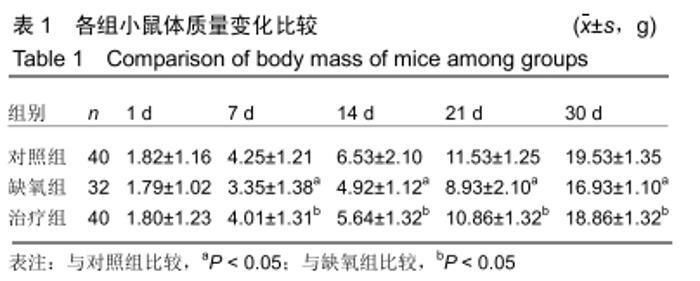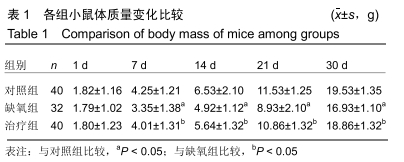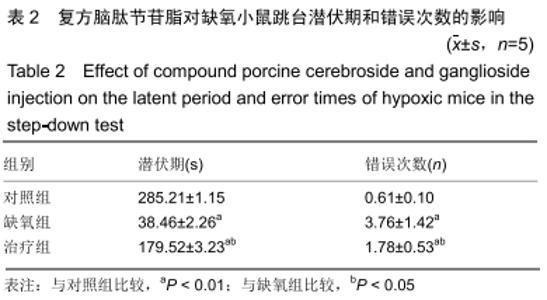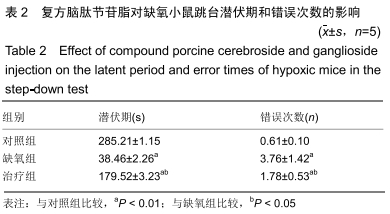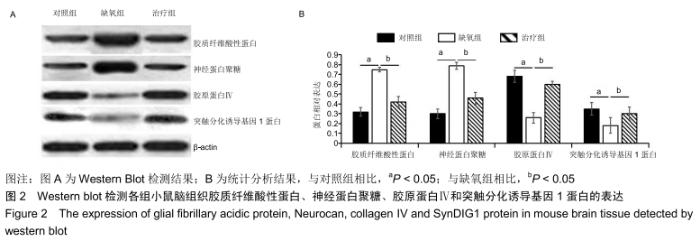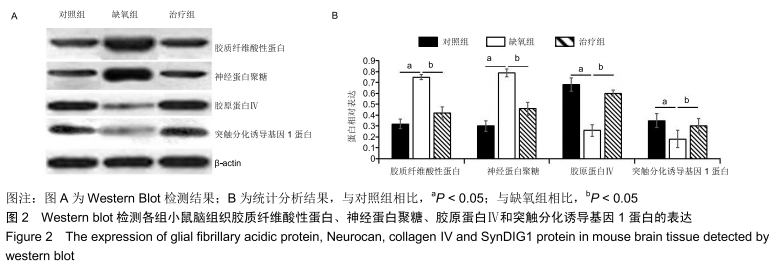Chinese Journal of Tissue Engineering Research ›› 2020, Vol. 24 ›› Issue (11): 1689-1694.doi: 10.3969/j.issn.2095-4344.2478
Previous Articles Next Articles
Compound brain peptide ganglioside can improve intrauterine hypoxia-induced neonatal brain injury and promote synapse regeneration in a mouse model
Zhang Fuhua1, Fan Wenjuan2, Hua Xinyu3, Chen Xudong3
- 1Department of Traditional Chinese Medicine, 2Laboratory for Molecular Medicine, 3Department of Histology and Embryology, Luohe Medical College, Luohe 462002, Henan Province, China
-
Received:2019-07-13Revised:2019-07-16Accepted:2019-08-09Online:2020-04-18Published:2020-02-27 -
Contact:Chen Xudong, Master, Associate professor, Department of Histology and Embryology, Luohe Medical College, Luohe 462002, Henan Province, China -
About author:Zhang Fuhua, Master, Associate professor, Department of Traditional Chinese Medicine, Luohe Medical College, Luohe 462002, Henan Province, China -
Supported by:the Scientific and Technological Breakthrough Foundation of Henan Province, No. 182102310083
CLC Number:
Cite this article
Zhang Fuhua, Fan Wenjuan, Hua Xinyu, Chen Xudong. Compound brain peptide ganglioside can improve intrauterine hypoxia-induced neonatal brain injury and promote synapse regeneration in a mouse model [J]. Chinese Journal of Tissue Engineering Research, 2020, 24(11): 1689-1694.
share this article
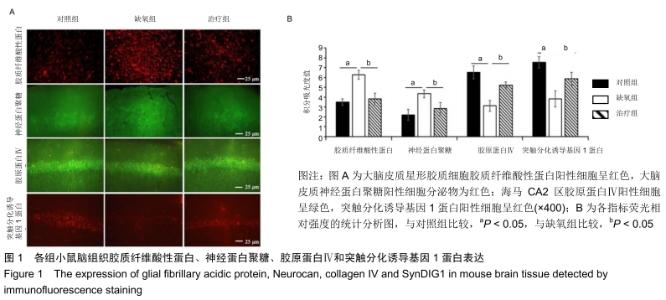
2.4 免疫荧光测胶质纤维酸性蛋白、神经蛋白聚糖、胶原蛋白Ⅳ和SynDIG1表达 胶质纤维酸性蛋白、神经蛋白聚糖和胶原蛋白Ⅳ均为胞质和轴突着色(胶质纤维酸性蛋白主要表达于星形胶质细胞的胞浆,神经蛋白聚糖和胶原蛋白Ⅳ主要表达主要表达于神经元胞质和轴突),与对照组比较,缺氧组脑皮质胶质纤维酸性蛋白、神经蛋白聚糖阳性细胞表达明显增强(P < 0.05);而治疗组鼠脑皮质中胶质纤维酸性蛋白、神经蛋白聚糖的表达水平与缺氧组相比则显著减弱(P < 0.05),见图1。与对照组相比,缺氧组脑海马CA2区胶原蛋白Ⅳ阳性物表达强度明显减弱(P < 0.05);而治疗组鼠脑海马CA2区胶原蛋白IV的表达水平较缺氧组显著增强(P < 0.05),见图1。SynDIG1在突触位点囊泡表达,呈点块状着色,与对照组相比,缺氧组脑海马CA2区SynDIG1阳性物表达强度明显减弱(P < 0.05);而治疗组鼠脑海马CA2区SynDIG1的表达水平较缺氧组则显著增强 (P < 0.05);与对照组相比,缺氧组各指标差异无显著性意义(P > 0.05),见图1。 "
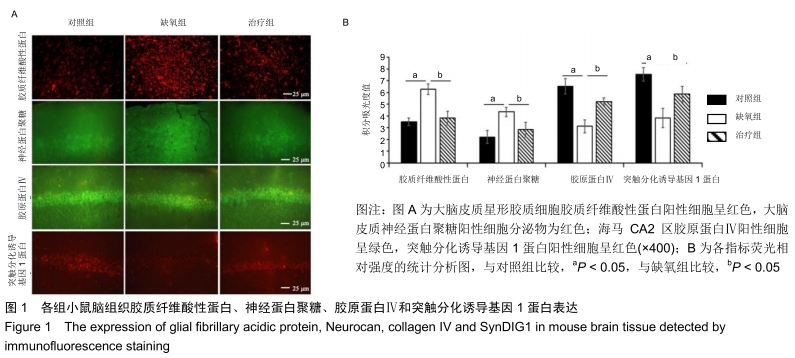
| [1] WANG M, ZHANG Y, FENG L, et al.Compound porcine cerebroside and ganglioside injection attenuates cerebral ischemia- reperfusion injury in rats by targeting multiple cellular processes. Neuropsychiatric Disease and Treatment.2017;13:927-935. [2] DUKHINOVA M, VEREMEYKO T, YUNG AWY, et al. Fresh evidence for major brain gangliosides as a target for the treatment of Alzheimer's disease.Neurobiol Aging.2019;77( 4):128-143. [3] 黄伟毅,关良劲.亚低温联合复方脑肽节苷脂注射液治疗重症颅脑损伤的临床疗效及生活质量研究[J].脑与神经疾病杂志,2018,26 (2): 100 -104. [4] ZHU X, LI H, ZHANG C.Clinical effects of Ganglioside and fructose-1, 6-diphosphate on neonatal heart and brain injuries after Asphyxia.Pak J Med Sci.2017;33(5):1199-1204. [5] MIAO Y, WANG R, WU H, et al.CPCGI confers neuroprotection by enhancing blood circulation and neurological function in cerebral ischemia/reperfusion rats. Mol Med Rep. 2019;20(3):2365-2372. [6] 徐悦,郑永强,付蓓蓓.复方脑肽节苷脂对脑缺血再灌注损伤模型大鼠的保护作用[J].中国药业,2019,28(10):13-16. [7] YUE HS, CHEN XD, ZHONG XM, et al.Effect of Angelica sinensis on neural stem cell proliferation in neonatal rats following intrauterine hypoxia.Neural Regen Res.2008;3(7),733-736. [8] 陈旭东,徐纪伟,王晓兰.小鼠诱导多能干细胞移植治疗宫内缺氧新生鼠脑损伤[J].解剖学杂志,2016,39(1):26-30. [9] 王明洋,冯璐,范姝婕,等.复方脑肽节苷脂注射液激活线粒体自噬改善脑缺血再灌注损伤[J].中国康复理论与实践,2016,22(7): 750-753 [10] MARINA N, KASYMOV V, ACKLAND GL, et al.Astrocytes and Brain Hypoxia.Adv Exp Med Biol.2016;903:201-207. [11] CHOI SH, KIM HJ, CHO HJ, et al. Gintonin-mediated release of astrocytic vascular endothelial growth factor protects cortical astrocytes from hypoxia-induced cell damages.J Ginseng Res. 2019;43(2):305-311. [12] SU Z, YUAN Y, CHEN J, et al. Reactive astrocytes in glial scar attract olfactory ensheathing cells migration by secreted TNF-alpha in spinal cord lesion of rat.PLoS One.2009;4(12): e8141. [13] 邓之婧,郭哲,庞逸敏,等.小鼠脑缺血后星形胶质细胞和小胶质细胞的活化规律比较[J].中华老年心脑血管病杂志, 2016,18(1): 77-80. [14] ZHANG S, WU M, PENG C, et al.GFAP expression in injured astrocytes in rats.Exp Ther Med.2017;14(3):1905-1908. [15] SILVER J, MILLER JH.Regeneration beyond the glial scar[J]. Nat Rev Neurosci.2004;5(2):146-156. [16] MIYATA S, KITAGAWA H.Mechanisms for modulation of neural plasticity and axon regeneration by chondroitin sulphate.J Biochem. 2015;157(1):13-22. [17] FONTANIL T, MOHAMEDI Y, MONCADA-PAZOS A, et al. Neurocan is a New Substrate for the ADAMTS12 Metalloprotease: Potential Implications in Neuropathies.Cell Physiol Biochem.2019; 52(5):1003-1016. [18] YUI S, FUJITA N, CHUNG CS, et al.Olfactory ensheathing cells (OECs) degrade neurocan in injured spinal cord by secreting matrix metalloproteinase-2 in a rat contusion model.Jpn J Vet Res. 2014; 62(4) :151-162. [19] SUN X, REN Z, PAN Y, et al.Antihypoxic effect of miR-24 in SH-SY5Y cells under hypoxia via downregulating expression of neurocan.Biochem Biophys Res Commun.2016;477(4):692-699 [20] XU L, NIRWANE A, YAO Y.Basement membrane and blood-brain barrier.Stroke Vasc Neurol.2018;4(2):78-82. [21] SUN ZL, JIANG XF, CHENG YC, et al.Exendin-4 inhibits high-altitude cerebral edema by protecting against neurobiological dysfunction.Neural Regen Res. 2018;13(4):653-663. [22] LEE WLA, MICHAEL-TITUS AT, SHAH DK. Hypoxic-Ischaemic Encephalopathy and the Blood-Brain Barrier in Neonates.Dev Neurosci.2017;39(1-4):49-58. [23] PEDCHENKO V, BAUER R, POKIDYSHEVA EN, et al.A chloride ring is an ancient evolutionary innovation mediating the assembly of the collagen IV scaffold of basement membranes.J Biol Chem. 2019;294(20):7968-7981. [24] 李仁斌,余光书,林焱斌,等.依达拉奉干预脊髓损伤模型大鼠Ⅰ型和Ⅳ型胶原蛋白的表达[J].中国组织工程研究,2018,22(8):1235-1240. [25] TAKEUCHI M, YAMAGUCHI S, YONEMURA S, et al.Type IV Collagen Controls the Axogenesis of Cerebellar Granule Cells by Regulating Basement Membrane Integrity in Zebrafish.PLoS Genet.2015;11(10): e1005587. [26] ŽALOUDÍKOVÁ M, ECKHARDT A, VYTÁŠEK R, et,al. Decreased collagen VI in the tunica media of pulmonary vessels during exposure to hypoxia: a novel step in pulmonary arterial remodeling.Pulm Circ.2019;9(3):2045894019860747. [27] LEROY F, BRANN DH, MEIRA TINPUT, et al.Timing-Dependent Plasticity in the Hippocampal CA2 Region and Its Potential Role in Social Memory.Neuron.2017;95(5):1089-1102. [28] LEE SE, SIMONS SB, HELDT SA, et al.RGS14 is a natural suppressor of both synaptic plasticity in CA2 neurons and hippocampal-based learning and memory.Proc Natl Acad Sci U S A. 2010;107(39):16994-16998. [29] BENOY A, DASGUPTA A, SAJIKUMAR S.Hippocampal area CA2: an emerging modulatory gateway in the hippocampal circuit.Exp Brain Res.2018;236(4):919-931. [30] DÍAZ E.SynDIG1 regulation of excitatory synapse maturation.J Physiol.2012;590(1):33-38. [31] KAUR I, YAROV-YAROVOY V, KIRK LM, et al.Activity-Dependent Palmitoylation Controls SynDIG1 Stability, Localization, and Function.J Neurosci.2016;36(29):7562-7568. [32] KIRK LM, TI SW, BISHOP HI, et al.Distribution of the SynDIG4/proline-rich transmembrane protein 1 in rat brain.J Comp Neurol.2016;524(11): 2266-2280. |
| [1] | Liu Jinwei, Chen Yunzhen, Wan Chunyou. Changes of osteogenic growth factors in the broken end of bone nonunion under stress [J]. Chinese Journal of Tissue Engineering Research, 2021, 25(23): 3619-3624. |
| [2] | Zhang Liang, Ma Xiaoyan, Wang Jiahong. Regulatory mechanism of Shenshuai Yin on cell apoptosis in the kidney of chronic renal failure rats [J]. Chinese Journal of Tissue Engineering Research, 2021, 25(23): 3672-3677. |
| [3] | Lu Jie, Li Xue, Wang Lu, Fan Jia, Zhang Yeting, Lu Xiaobin, Yuan Qiongjia. Effects of different-intensity swimming exercises on spatial learning and memory ability and the expression of Orexin A in the rat cerebellum [J]. Chinese Journal of Tissue Engineering Research, 2021, 25(23): 3697-3703. |
| [4] | Yang Xinhua, Yan Yindi, Luo Xuguang, Yang Yanping, Li Hairong, Cui Huilin, Cao Ximei. Bmal1 and Clock regulate the development and differentiation of skeletal muscle [J]. Chinese Journal of Tissue Engineering Research, 2021, 25(20): 3130-3137. |
| [5] | Wang Jing, Wu Jiangbo. Irisin mediates protective effects on failing heart via integrin alpha V receptors [J]. Chinese Journal of Tissue Engineering Research, 2021, 25(20): 3219-3225. |
| [6] | He Fan, Xiong Xiuli, Shan Xianfeng, Zhang Shutong, Hu Jian, Wang Xuejin. Guided bone regeneration in a small animal model of critical size craniofacial bone defects [J]. Chinese Journal of Tissue Engineering Research, 2021, 25(20): 3226-3231. |
| [7] | Li Shang, Huang Xiang, Chen Ming, Lei Mingxing, Cheng Shi, Zhang Licheng, Yin Pengbin, Tang Peifu. Semaphorin 3A is expected to be a new target for the repair of skeletal muscle injury [J]. Chinese Journal of Tissue Engineering Research, 2021, 25(20): 3232-3238. |
| [8] | Lin Haiqi, Chen Liang, Tang Lu, Weng Xiquan, Lin Wentao. Significance of urinary proteomics assessing pathological changes in the body [J]. Chinese Journal of Tissue Engineering Research, 2021, 25(20): 3259-3266. |
| [9] | Han Lei, Liu Haiying, Zhang Hao. Numerical analysis of the mechanical behaviors of cartilage in various levels of osteoarthritis in a gait cycle [J]. Chinese Journal of Tissue Engineering Research, 2021, 25(18): 2810-2815. |
| [10] | Hu Wandong, He Jialin, Zhang Longsheng, Liao Wenbo. Differential proteomics study of patients with sternal ossification of the ligamentum flavum [J]. Chinese Journal of Tissue Engineering Research, 2021, 25(17): 2625-2629. |
| [11] | Zhu Shiqiang, Xu Jianfeng, Hei Xiaoyan, Chen Yundong, Tian Xinbao, Zhang Jinchen, Lin Ruizhu. Effect of internal heat-type acupuncture needle therapy on the expression of type I collagen, matrix metalloproteinase-3 and osteopontin in the subchondral bone of rabbit knee osteoarthritis model [J]. Chinese Journal of Tissue Engineering Research, 2021, 25(17): 2636-2642. |
| [12] | Ailimaierdan·Ainiwaer, Wang Ling, Gu Li, Dilidaer•Taxifulati, Wang Shan, Yin Hongbin. Effect of transforming growth factor-beta3 on the proliferation and osteogenic capability of osteoblasts [J]. Chinese Journal of Tissue Engineering Research, 2021, 25(17): 2664-2669. |
| [13] | Huang Yunmei, Feng Fangfang, Chen Wenlie, Lu Xiaodong, Lin Ruhui, Li Zuanfang, Huang Meiya, Tan Chunjiang, Li Xihai, Li Xiaodong. Anti-inflammatory and anti-swelling effects of Tougu Xiaotong Capsule in rat models of early osteoarthritis with synovial edema [J]. Chinese Journal of Tissue Engineering Research, 2021, 25(17): 2697-2702. |
| [14] | Zhang Shuang, Tan Rui, Wang Chunxiao, Wu Fengyu, Guo Hongyu. MicroRNAs for assessing the motion control of human skeletal muscles [J]. Chinese Journal of Tissue Engineering Research, 2021, 25(17): 2755-2760. |
| [15] | Zhang Yunqing, Wang Jian, Yang Chunhua, Li Cong. Effects of miR-335-5p on proliferation and apoptosis of osteoarthritic chondrocytes by targeting programmed cell death 5 [J]. Chinese Journal of Tissue Engineering Research, 2021, 25(14): 2142-2147. |
| Viewed | ||||||
|
Full text |
|
|||||
|
Abstract |
|
|||||
